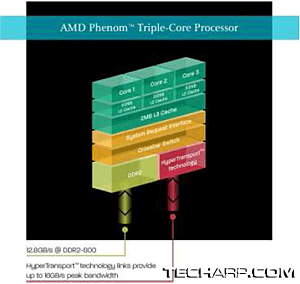A Tale Of Three Cores
Like their quad-core Phenom brethren, the new triple-core Phenom processors will have 512MB L2 cache per core and share a unified 2MB L3 cache. It will also use the same integrated DDR2 memory controller. In other words, it is no different than the quad-core Phenom processor with one core disabled.
We can't say we are surprised by this move. In fact, it was really a matter of time before AMD converted their "broken" quad-core processors into triple-core processors. The large, monolithic die (roughly 285 mm2) of the quad-core Phenom processor makes it harder and more expensive to produce dies with all cores fully functional, or capable of running at high speeds.
This is why Intel chose to stick with dual-core dies, at least for the moment. Being much smaller, they are cheaper and easier to produce and qualify at higher clock speeds. Intel can match two dies of similar speeds to produce quad-core processors of specific speed grades. This allows them to achieve higher clock speeds for their quad-core processors than might be possible with a monolithic design.
Because of the monolithic design, AMD does not have such luxury. Damage to even a single core renders the processor useless as a quad-core processor. Similarly, qualifying all four cores in a monolithic design for a particular clock speed is much harder than doing so for a dual-core die. AMD will inevitably end up with a whole lot of quad-core processor dies that have one or more cores that are either non-functional, or cannot run as fast as the other cores.
Therefore, it only makes sense to recover some of these "imperfect" processors by disabling one non-functional/slower core and turning them into triple-core processors. Instead of being silicon scrap or making pretty little keychains, they can now be sold as cheaper, fully-functional processors. This is exactly why and how AMD creates these "triple-core threats".
Of course, production of these triple-core processors do not necessarily need to rely on a steady supply of "broken" quad-core processors. AMD will gradually improve the yield of their quad-core processors. When demand exceeds supply, AMD can cripple fully-functional quad-core processors to make triple-core processors. It's all a matter of supply and demand. It's all about dollars and cents (and sense too!).
<<< ED#57 : The AMD Phenom Goes Triple Core!, The New Roadmap : Previous Page | Next Page : What We Think >>>








 Add to Reddit
Add to Reddit

